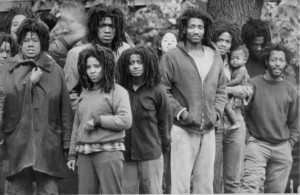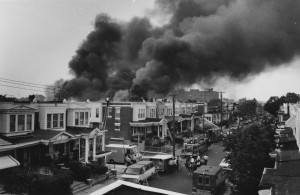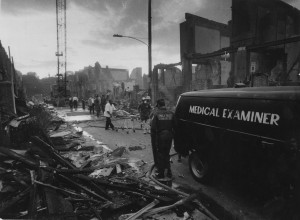One of the most notorious and controversial episodes in Philadelphia’s history occurred on May 13, 1985: the bombing of the MOVE Organization’s house in the Cobbs Creek neighborhood of West Philadelphia.

After years of tension and conflict among MOVE, city authorities, and some local residents, including a shootout with police in 1978 which left one officer dead, Philadelphia officials decided to evict members of the communal-living, back-to-nature Black Liberation group from their fortified house at 6221 Osage Avenue. (Accounts differ on who actually fired the shots that killed the police officer.)
On the morning of May 13, 1985, a violent confrontation erupted, with tear gas and thousands of rounds of bullets exchanged–resulting in a daylong standoff. To break the stalemate, Police Commissioner Gregore Sambor ordered the Police Bomb Unit to drop two satchel bombs from a helicopter onto a wooden bunker that had been constructed on top of the house. A tremendous fire broke out. Witnesses say that when MOVE members ran out of the burning building, police continued to shoot at them. The Fire Department, ordered by police to “let the fire burn,” delayed putting out the flames, claiming that MOVE members were still firing, but witnesses assert that the wait was deliberate.
The fire spread to adjoining houses, and two entire city blocks went up in flames, leaving 11 members of the group dead, including MOVE’s founder John Africa and five children who were in the house. Two hundred-fifty local residents were left homeless.
 In the aftermath of these events, Mayor W. Wilson Goode convened the Philadelphia Special Investigation Commission (PSIC) to examine the incident. The head of the Commission, William Brown III, had led the Federal Equal Employment Opportunities Commission, and the rest of the commission’s eleven members included prominent individuals from a variety of backgrounds.
In the aftermath of these events, Mayor W. Wilson Goode convened the Philadelphia Special Investigation Commission (PSIC) to examine the incident. The head of the Commission, William Brown III, had led the Federal Equal Employment Opportunities Commission, and the rest of the commission’s eleven members included prominent individuals from a variety of backgrounds.
The commission conducted dozens of interviews, gathered a large amount of evidence, and held public hearings. In March 1986, it issued a scathing report which was highly critical of government actions, stating that “Dropping a bomb on an occupied row house was unconscionable.”
With in the Urban Archives, Temple University Libraries’ Special Collections Research Center (SCRC) holds the records of the Philadelphia Special Investigation Commission (PSIC), as well as a wealth of related photographs, audio-visual materials, and news clippings on this topic and the MOVE organization.
Consisting of 29 cubic feet of materials, PSIC Records provide a comprehensive account of the tragic events of that day. At the core of this collection are interviews the commission conducted, under subpoena power, with every policemen, firemen, public official, and resident involved. Supporting and related documentary evidence submitted by witnesses are also a part of these files, as well as approximately 700 photographs gathered or produce by the commission.
There are also hours of footage and transcripts from the televised hearings that ran on WHYY, as well as television news coverage of the event itself and of MOVE before and after the 1985 incident from WPVI and KYW.
There are hundreds of images in the Philadelphia Inquirer and Philadelphia Evening Bulletin photograph collections. The Inquirer Photographs contain over 300 images, the majority of which pertain to the 1985 conflict, the PSIC hearings, rebuilding, and the impact on the surrounding community. The Philadelphia Evening Bulletin Photographs have over 550 images, documenting the communal life of MOVE as well as its previous clashes with the police during the 1970s. (The Evening Bulletin closed in 1982). Many of the Evening Bulletin photographs have been digitized and can be found in our digital collections.
It is safe to say that the SCRC houses the most comprehensive collection of primary sources available on this topic. Numerous students, documentarians, historians, and community members have drawn upon the archives to try to make sense of the events of that day. In 2013, a documentary by film maker Jason Osder made extensive use of these materials in his award winning film Let the Fire Burn.
To view these or other materials in the SCRC, please contact us at SCRC@temple.edu or visit our website.
–Josué Hurtado, Coordinator of Public Services & Outreach, SCRC